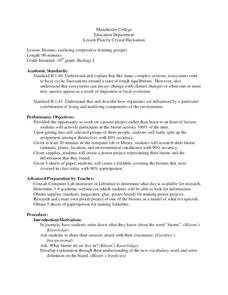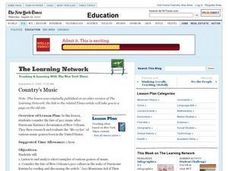Curated OER
Get Your Facts Right!
Students explore the life and the contributions of Christopher Columbus. In this Exploration Age lesson plan, students participate in several activities regarding the explorer. Students use the Internet and print resources to research...
Curated OER
Pond Theme Unit
For this pond theme worksheet students research facts on pond life. Students complete comprehension questions, crosswords, word search, and math puzzles. Students write a short report.
Curated OER
Sound Waves
Students explore sound. In this "sound" science lesson, students define sound and explain how sound travels. Students experiment with paper cups and string to conclude how sound travels. Students research a chosen aspect of sound with a...
Curated OER
Dimming The Sun
Students review the meanings of global warming and global dimming. While watching a video, they take notes on different aspects of the issue. In groups, they develop a list on what can be done to reduce global dimming. They...
Curated OER
An Introduction to Islam and Muhammad
Students view a video regarding Islam and take notes on the video as they watch it. They complete a vocabulary sheet, timeline sheet, and worksheet regarding what they learned about Islam.
Curated OER
The "Pick-Your-Favorite-Bat" Report
Students research one of the bats listed in the lesson plan. In this research lesson, students write a report using Microsoft Word and draw a picture that can be shared.
Curated OER
Biomes
Tenth graders research locations of biomes and their barriers. In this biomes lesson, 10th graders examine location, environmental conditions, and species of plants and animals that live in the biome. Students take notes and create a...
Curated OER
Consider Your Options-Plastics
Students explore plastics and what plastics students use to pack a lunch. In this plastics lesson plan, students observe each other pack lunches and take note of all the plastics used in packing the lunch. They discuss the impact of...
Curated OER
Finding Historical Evidence: David Brion Davis
Students study the Tran-Atlantic Slave Trade and learn to evaluate historical arguments. In this slave trade lesson, students read about the Atlantic Slave System. Students take notes on slave trade and make a timeline for the...
Curated OER
Lincoln's Legend and Legacy
Students evaluate Lincoln's impact on American History. In this Civil War lesson, students view a film clip of writings about Lincoln. Students take notes and compare how the writings define his legacy. Students write their own poem or...
Curated OER
The Salt Water Connection
Students investigate the various factors that influence the Pacific Ocean and Monterey Bay, California. They watch a video about Monterey Bay and take notes, and conduct research and write a report about a specific organism living in...
Curated OER
The Civil War
Students, examine The Civil War, from a variety of perspectives and assignments. After taking notes, they can choose from creating a front page newspaper article describing the fall of Fort Sumter, discuss the pros and cons of fighting,...
Curated OER
Identifying Mammals
Learners investigate mammals. In this biology lesson, students use various websites to investigate mammals and their body parts. Learners take notes the websites.
Curated OER
Night Lesson Plan: Stereotypes and Scapegoats
Young scholars read the novel Night by Holocaust survivor Elie Wiesel and complete related activities. In this novel analysis instructional activity, students prompt write and discuss the answers. Young scholars take notes on stereotypes...
Curated OER
The Greenhouse Effect
Eighth graders research the Greenhouse Effect on the Internet. They use a variety of sources and take notes on the topic. They use ClarisWorks to type a report, use spellcheck, proof and edit. They can create a class bulletin board.
Curated OER
The Waterfront Debate
Tenth graders debate a resolution about a planned waterfront community from the point of view of various interest groups. They have a "Town Meeting" in which members from each interest group debate their researched opinions for points....
Curated OER
Escher-Esque Tessellations
Middle and high schoolers participate in a seven-part lesson creating Escher-Esque tessellations. They demonstrate their knowledge of geometric transformations after viewing a PowerPoint presentation, conducting Internet research, and...
Curated OER
Recreate the Race
Learners research and find the route of the Alaskan dog sled race.In this Iditarod race lesson students find the checkpoints for the Iditarod on a map. Learners research information in pairs about each one of the checkpoints. Students...
Curated OER
Country's Music
Jazz, Blue Grass, Hip Hop, Swing. Gospel, R&B, Ragtime, Disco. So many music genres born in the USA. After reading an article about the fate of New Orlean's Jazz after Hurricane Katrina, class members investigate the life cycles of...
Smithsonian Institution
The Soldier’s Experience—Vietnam versus World War I
The Vietnam War and World War I were two very important—and different—wars. To understand the differences, and similarities, class members watch videos, examine primary source documents, and then create a newscast that examines the...
Curated OER
The Water Cycle - Main Components
Present the water cycle to your middle schoolers with this lesson. After an anticipatory set, they participate in a Q & A session about the terms associated with the water cycle: evaporation, transpiration, condensation, and...
Curated OER
Lesson on 'The Chimney Boy's Story' by Wes Magee
Wes Magee's poem "The Chimney Boy's Story" about chimney sweeps/climbing boys is used as an introduction to a lesson that asks groups to research child labor in Victorian Britain.
Curated OER
Hoot: KWHL
How can we help endangered animals? Learn about which animals are endangered and what people can do to protect them with a lesson based on Carl Hiaasen's Hoot. After completing a KWHL chart to note what they already know and what they...
UNICEF
What is Voluntary Counselling and Testing?
A lesson about counseling through the HIV testing process brings up important facts about HIV, how patients can decide to test for the virus, and what makes a positive or negative test. It includes a flowchart that takes learners through...

























